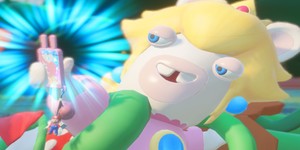Gameplay
The gameplay itself is fairly straight forward and gaming veterans (and non veterans thanks to the introduction of virtual console and an updated DS port) will just have to consider that Galaxy is basically Super Mario 64 but taken to the next level.The gameplay layout is pretty much identical to the old Super Mario 64 format – there are a variety of levels for players to explore, each one of which has a number of sub-levels and there’s a hub for players to return to between missions.
In this case, the hub is the Cosmic Observatory inhabited by Rosalina and the Luma creatures which she rules over. The observatory has a number of different rooms in it, each of which houses a star portal that Mario can use to launch himself to a nearby galaxy.
In every galaxy, each of which has a different theme, there’s a number of different Power Stars that have been hidden. Players have to defeat the level to gain a Power Star – a process which may involve a boss to defeat, puzzles to solve or a secret to discover. Once enough Power Stars have been gathered, new rooms and galaxies are opened up and Mario can travel to a whole new galaxy without even needing a spacesuit. Captain Kirk never had it that easy.
Each galaxy is entirely different to the one before it and some unlock new powers and abilities for Mario while others simply enforce new styles of gameplay on the player. Take the first galaxy for example; it’s small and the Mario can run right around the individual planets in a few seconds. There’s a large number of planets to explore though and player can hop from one to another very easily and quickly.
In fact, the first levels are especially fantastic for a number of reasons. The directional gravity that takes effect when Mario moves and which keeps him hugging the surface of the planet he’s on make the game awesomely nauseating and utterly enjoyable. The individual planets are quite imaginative too, ranging from simple balls of rock to figure of eight shaped planets which are encased in glass.
Now, contrast that with the second galaxy – which has a garden theme and is filled with bees. Here, Mario can drink honey that turns him into Bee Mario, a transformation which allows him to fly through the air for short periods and to climb up honeycomb patterns on the walls.
This second galaxy is massively different to the first – not just because the greenery and flowers make it more pretty than the vast, cold expanse of space in the first galaxy, but also in gameplay style. As the game expands even more transformations come to light and soon Mario has more abilities under his belt, including being able to turn into Boo Mario, a rather ghostly version of his former self.
The levels which Mario finds himself exploring range from the fairly simple to the controller-wreckingly difficult and, just like in Super Mario 64, there’s bound to be a fair few stars that keep you stumped for a while. Still, that’s a major boon of the game design in my opinion – if you get stuck on the second star in a particular galaxy then there’s always something else to try out and another galaxy to explore.
Because each new galaxy usually requires an entirely different playing style to the ones before, it means that if you find yourself frustrated with one particular approach then there’s always a different way to play. This openness really makes the game a masterpiece of game-balancing, making it playable for gamers of all ages.
There are a few flaws in this delicious recipe though – the dialogue in particular was something that irked me because not only was it often quite repetitive, it was usually unskippable too. The first few times a Luma tells you how to fire star bits with the Wiimote is joyous, whimsical narrative - this can be quite charming. The third and fourth times you hear it though you’ll be mashing every button you can in vain as you try to skip the conversation and get back into game proper.

MSI MPG Velox 100R Chassis Review
October 14 2021 | 15:04












Want to comment? Please log in.